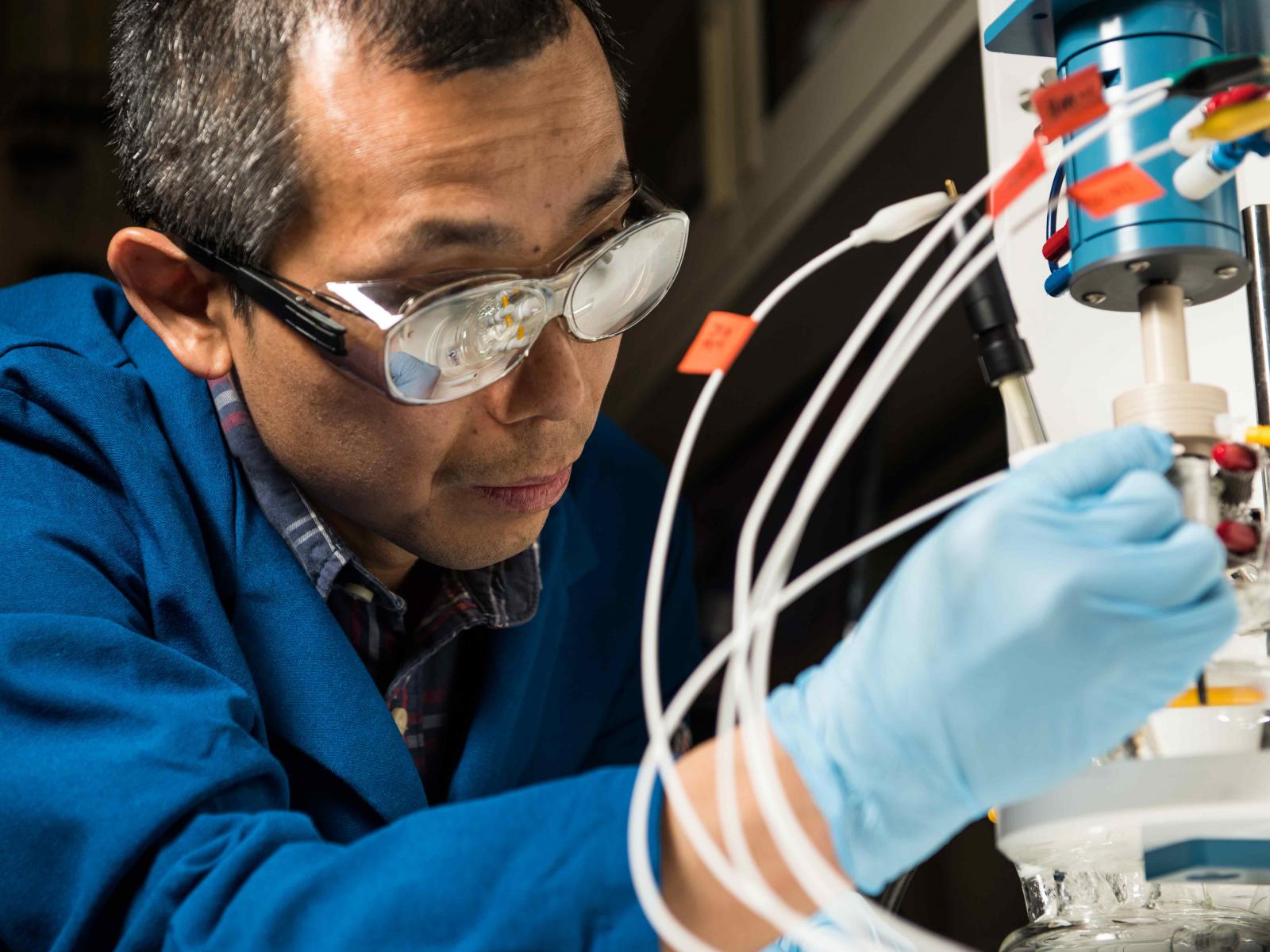Celebrate National Hydrogen and Fuel Cell Day

As part of Pacific Northwest National Laboratory's work to advance the widespread use of hydrogen and fuel cells, researcher Yuyan Shao tests inexpensive catalyst materials that could be cost-effective alternatives to the typical fuel cell catalysts that contain platinum or other precious metals.
Photo courtesy of Andrea Starr - Pacific Northwest National Laboratory
Hydrogen may be the first element on the periodic table, but this lightweight gas could be a heavy hitter for enhancing our nation's clean energy security.
At the Department of Energy's Pacific Northwest National Laboratory, our experts are conducting research and development that will enable the widespread use of hydrogen and fuel cells that could reduce our dependence on gasoline, diesel and coal.
Given hydrogen's atomic weight of 1.008, today - Oct. 8 (10-08) - is designated National Hydrogen and Fuel Cell Day. It is also Columbus Day - a fitting coincidence because, like Columbus, our researchers explore the unknown.
These researchers use their materials science and chemistry know-how and state-of-the-art instrumentation to understand and exploit the interplay of hydrogen and electrons. With support from DOE's Fuel Cell Technologies Office, they are working to address the cost, performance and safety challenges associated with fuel cells, as well as the production, storage and delivery of hydrogen as part of the DOE H2@Scale vision.
The way fuel cells produce electricity is similar to that of batteries; however, unlike batteries that lose their charge, fuel cells can operate continuously as long as they have fuel. PNNL has long been a leader in developing solid oxide fuel cells that run on various fuels for power generation and other applications.
PNNL researchers are investigating ways to lower the cost of polymer electrolyte membrane fuel cells, a technology often used in transportation applications, including vehicles, forklifts and drones. These fuel cells use hydrogen and operate at relatively low temperatures, but require expensive platinum catalysts to enable necessary reactions. PNNL is creating inexpensive nitrogen-based catalysts that deliver nearly the performance of platinum.
PNNL scientists also are seeking better ways to produce hydrogen for use in fuel cells and other applications, including industrial processes and steel manufacturing. One area of research focuses on increasing the efficiency of electrolysis, which produces hydrogen by using electricity to split the hydrogen and oxygen in water molecules.
Researchers are studying high-temperature electrolysis that may consume one-third less electricity than traditional lower-temperature electrolysis. In another effort, PNNL is teaming with other national laboratories to better understand biological hydrogen production processes, including how to get microbes to produce hydrogen instead of methane during fermentation.
Once hydrogen is produced, it needs to be stored and delivered—and our scientists are working on improvements here, too. For example, as part of a national consortium, they are developing innovative approaches to the development and characterization of hydrogen storage materials. In another consortium they are partnering with industry to study how hydrogen interacts with plastics, polymers and metals — at temperatures and pressures consistent with hydrogen production, storage and use.
PNNL researchers and their collaborators also are working to decrease the energy needed to liquefy hydrogen. Liquefaction makes it easier to store hydrogen in tanks or pump it into vehicles, but it is energy intensive and expensive. The team is developing a novel process to cool and liquefy hydrogen that shows promise of doubling efficiency while lowering costs. In one experiment, they liquefied a gas from room temperature for the first time, piquing the interest of several companies.
Lastly, PNNL promotes hydrogen safety and shares resources with the hydrogen community. A PNNL researcher leads a national team of engineers, code officials, safety professionals, equipment providers, and testing and certification experts. This team provides guidance for hydrogen projects and facilities, and offers hands-on first responder training. Thousands of stakeholders worldwide also rely on the wealth of information on PNNL's online hydrogen portal, H2tools.org.
Given hydrogen's atomic weight of 1.008, today - Oct. 8 (10-08) - is designated National Hydrogen and Fuel Cell Day. It is also Columbus Day - a fitting coincidence because, like Columbus, our researchers explore the unknown.
Perhaps today you will think about the scientists and engineers whose discoveries will unlock the potential of hydrogen and fuel cells to enhance our nation's clean energy security and economic vitality.
Steven Ashby, director of Pacific Northwest National Laboratory, writes this column monthly. His other columns and opinion pieces are available here.
Published: October 8, 2018